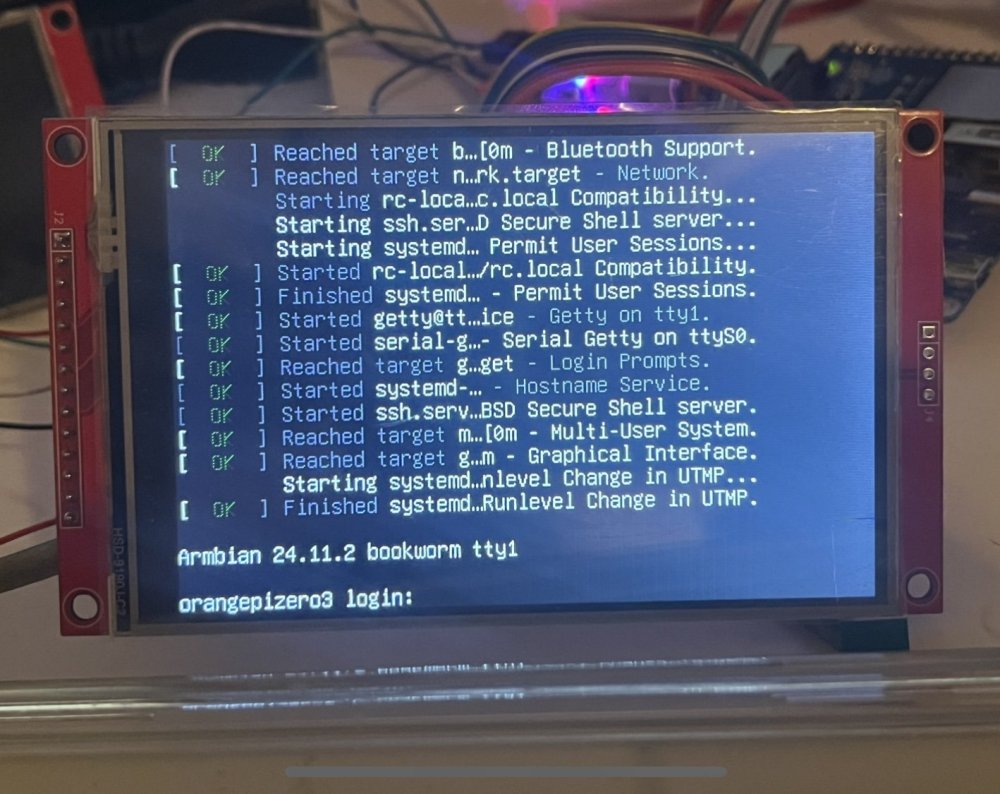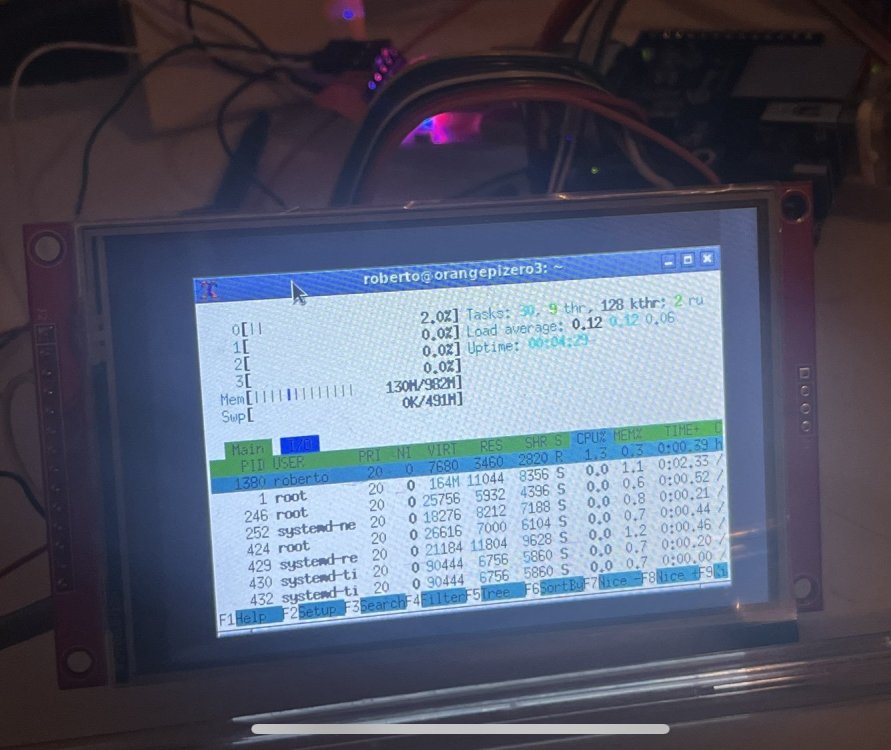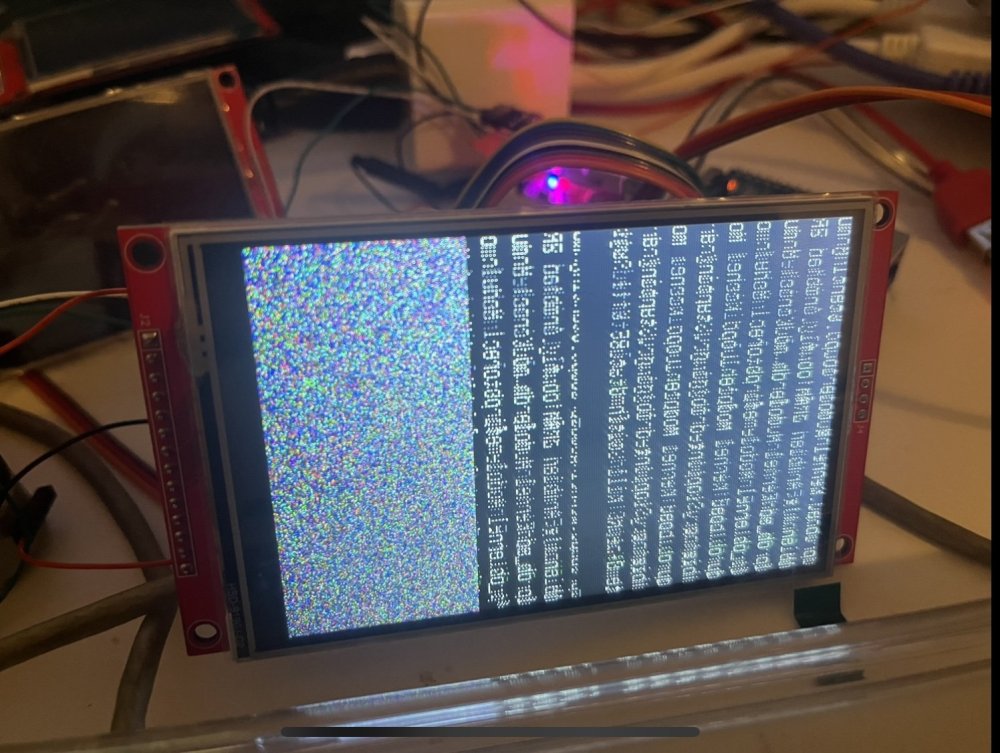
robertoj
Members-
Posts
522 -
Joined
-
Last visited
Content Type
Forums
Store
Crowdfunding
Applications
Events
Raffles
Community Map
Everything posted by robertoj
-
Check here for the byte command sequence for st7796s and combine with the dts in my thread https://forums.raspberrypi.com/viewtopic.php?t=380704 using the dts as is with your different touch controller likely wont hurt it, it may just throw error messages in dmesg|grep spi or delete the touch part of the dts, or disconnect the spi pins to the touch controller if you want to be safer.
-

NanoPi DUO2 microUSB serial stop working on 24.11.0
robertoj replied to Slawek's topic in Allwinner sunxi
👍🏽 check that there are no uboot errors related to loading that dtbo (right before loading the kernel). -
👍🏽 This is a problem with a specific dts meant for the spidev driver, because I am using the spi1 bus with 2 chip selects everyday with my LCD, which doesn’t use the spidev driver (uses dedicated LCD-spi driver). Do you have an older orange pi zero 3 Armbian image, and see if it works normally? can you rebuild Armbian with ./compile.sh, choose Linux edge (latest) and see if it works normally?
-

OrangePI Zero has no Audio on current community builds.
robertoj replied to Roman B's topic in Allwinner sunxi
thank you for posting the fix 👍🏽 Can you show the contents of armbianEnv.txt? Also find the sun8i-h3-analog-codec.dtbo file inside the /boot/dtb/… folder you can always check that overlays are being used, by looking at the uboot messages, before loading the kernel. https://docs.armbian.com/User-Guide_Armbian_overlays/ -

How to use XPT2046 touch controller 3.5inch RPi Display 480x320 pixels
robertoj replied to orangeee's topic in Orange Pi One
I have seen success cases with ili9341, ili9488 and st7796... and one guy is trying with the ili9486 over in the unsupported sunxi section of this forum. https://forum.armbian.com/topic/46824-orange-pi-zero-3-ili9486-tft-lcd/ https://forum.armbian.com/topic/47971-driving-the-ili9488-lcd-40-inch-cheap-chinese-clone/ https://forums.raspberrypi.com/viewtopic.php?t=358240&hilit=Ili9341#p2165638 I think that the success case of ili9488 (mine 😎), would be a good starting point. Use the same DTS, and look at the command byte sequence that the driver will use. Get the datasheet for both ili9488 and ili9486, to see if the same commands have different addresses and parameters. Search in google for arduino examples, which will include a byte sequence. Buy a ili9341 LCD, which has many success cases, and test that you can at least make that work. Then you can keep working with the same wiring. -
Try all combinations of (I have no idea why these things sometimes work): * Only define the PH26,PH27 in pins = "PC0", "PC1", "PC2", "PC23", "PH26", "PH27"; * only cs-gpios = <0>; //use default CS instead of cs-gpios = <&pio 2 23 0>; /* PC23 for CS */ Make sure that there are no erorrs in: dmesg|grep spi dmesg|grep mipi Usually these are good signs: lsmod|grep ili shows a loaded kernel module ls /dev/fb* shows a created video device
-
Change: reset-gpios = <&pio 7 27 1>; /* GPIO 24 */ to: reset-gpios = <&pio 7 27 0>; /* GPIO 24 */ Change the SPI speed to 24MHz Format your DTS so we can read it easily. Correct the comments with GPIO nnn because they are confusing. Show a wiring schematic between the BPI M2 Berry and your LCD Use the "Spoiler" (eye) button, so that your long texts don't take so much space.
-

Driving the ili9488 LCD (4.0 inch cheap chinese clone)
robertoj replied to robertoj's topic in Allwinner sunxi
Is anyone getting a jumpy cursor, and garbled image around the areas of window refresh? (only at times of touching the screen) I suspect it is caused by sharing the SPI bus with the ads7846 (XPT2040)... anyone knows? I don't have this issue when I use the USB mouse. I also experience the LCD going 3/4 black and frozen, when there are no input events. It restores to normal when I touch the screen or move the mouse (with a white washout/flash in the LCD). My app is continuosly painting pixels, and it happens after a few minutes of no input events. I already have: xset s off & xset s noblank xset s -dpms But it seems that I don't have "xset" installed in my debian bookworm. Fixed with apt install x11-xserver-utils -
Is this related to SPI flash? I use opiz3's SPI-1 (with 2 CS) everyday with my LCD
-

Testing Linux 6.12 in Orange PI Zero 3 (H618)
robertoj replied to robertoj's topic in Allwinner sunxi
Thank you KungfuPancake!! I tested the command byte sequence, Linux 6.11.9 and my DTS. My LCD is now working I posted the solution in the appropriate thread: https://forum.armbian.com/topic/47971-driving-the-ili9488-lcd-40-inch-cheap-chinese-clone/#findComment-208446 Going: if you make changes for Opiz3, I will continue testing them -

Driving the ili9488 LCD (4.0 inch cheap chinese clone)
robertoj replied to robertoj's topic in Allwinner sunxi
THANKS TO USER KungFuPancake, who showed me his github repo, where he indicates to use the latest Armbian-edge, and provides the a command byte sequence for the ili9488 https://github.com/KungfuPancake/v0_ips_touch_display?tab=readme-ov-file If you see inverted colors, edit the panel-mipi-dbi-spi.txt and comment the line #command 0x21 before using the mipi-dbi-cmd If you have the cheap chinese clone LCD (see first post), use this DTS (change the gpio codes as needed): -

Testing Linux 6.12 in Orange PI Zero 3 (H618)
robertoj replied to robertoj's topic in Allwinner sunxi
Thank you The panel-mipi-dbi-spi driver, with the improvement it got in Linux 6.11, would be able to drive the ili9488 with the standard mipi protocol. It just needs to have the correct init byte commands. See: https://forum.armbian.com/topic/47971-driving-the-ili9488-lcd-40-inch-cheap-chinese-clone/#findComment-208043 -

Testing Linux 6.12 in Orange PI Zero 3 (H618)
robertoj replied to robertoj's topic in Allwinner sunxi
When I activated all the H6, H616, H618 patches, I get 3 patching errors: The 1st patch arm64-dts-H616-Add-overlays-that-are-also-compatible-with-orang is failing because I don't have these lines in the arch/arm64/boot/dts/allwinner/overlay/Makefile sun50i-h616-spi-spidev.dtbo sun50i-h616-spidev0_0.dtbo sun50i-h616-spidev1_0.dtbo Which patch file would insert those lines? Or should I edit the patch file to match the existing Makefile? -

Testing Linux 6.12 in Orange PI Zero 3 (H618)
robertoj replied to robertoj's topic in Allwinner sunxi
A virtualbox instance with 1 CPU and 2GB RAM inside this real PC: CPU: Intel i5-6300U (4) @ 3.000GHz RAM 8GB I started from scratch OK, I will activate all H6, H616 patches -

Testing Linux 6.12 in Orange PI Zero 3 (H618)
robertoj replied to robertoj's topic in Allwinner sunxi
I started with including this patch: patches.armbian/arm64-dts-H616-Add-overlays-that-are-also-compatible-with-orang.patch But it failed with this message: Maybe I need another patch together with this... one patch that adds the lines expected in the reject text -
I suddenly have a need to test Linux 6.11 or greater, because there's a needed improvement in the panel-mipi-dbi-spi driver (thread keyword ili9488) User "The Going" has kindly advised me to try his Armbian branch with Linux 6.12, so I am here sharing results as I test it with my Orange Pi Zero 3. Initial instructions: https://forum.armbian.com/topic/35635-armbian-242-is-broken-on-orange-pi-pc2/#findComment-207980 At first try, I decided to NOT follow this step: armbian/build> egrep '^-' patch/kernel/archive/sunxi-6.12/series.conf (finds all the excluded patches) Well, I continued. Choosing Linux Edge, shallow option, Bookworm minimal, there were zero problems: no patching errors and no compilation errors. At the end of the 4 hour compilation, I tested the resulting image in my Orange Pi Zero 3... and it booted fine. Not working at this moment: wifi (#iw dev returns nothing) spi1 (failed on fdt_overlay_apply(): FDT_ERR_NOTFOUND when I use a dts overlay that works in Linux 6.7) usb (lsusb only shows the 2 root hubs, but not my usb devices) when I decompile sun50i-h618-orangepi-zero3.dtb there is no references to spi1 or hdmi (maybe more) Working: serial console ethernet other things not tested Next, I am going execute armbian/build> egrep '^-' patch/kernel/archive/sunxi-6.12/series.conf and find specific patches that maybe will improve my hardware situation. Result of that egrep search command, with patches I will try first, one by one, in bold
-

How to use XPT2046 touch controller 3.5inch RPi Display 480x320 pixels
robertoj replied to orangeee's topic in Orange Pi One
What controller is it? ili9486, ili9488 or st7796s? -
Try the methods here:
-
I am currently in the middle of getting ili9488 working. check this thread https://forum.armbian.com/topic/47971-driving-the-ili9488-lcd-40-inch-cheap-chinese-clone/ and if possible, collaborate with the experiments I am trying The ili9341 is already solved: search "orange pi zero 3 ili9341" ... I used the driver with DRM, which has more efficient GPU and video acceleration
-
Hello Donit, Did you have success with ili9488? If yes, please share how you did it If not, check my thread and try my steps... then possibly you can fix what's bugging me
-

Driving the ili9488 LCD (4.0 inch cheap chinese clone)
robertoj replied to robertoj's topic in Allwinner sunxi
My efforts to use the panel-mipi-dbi-spi driver: DTS Init sequence panel-mipi-dbi-spi.txt compile and install this init command byte sequence (I don't know how to use an arbitrary bin file in the DTS😞 ./mipi-dbi-cmd panel-mipi-dbi.bin panel-mipi-dbi-spi.txt sudo cp panel-mipi-dbi.bin /lib/firmware/ Make sure that the DTS was given to the kernel: look for "Applying user provided DT overlay mipi-ili9488-ads7846.dtbo" without errors before starting kernel Make sure that the panel-mipi-dbi.bin was read by the driver: dmesg|grep mipi , look for no errors like "No config file found for compatible 'ili9488-init,panel-mipi-dbi-spi' (error=-2)" Successfully loaded driver should look lije this: roberto@orangepizero3:~$ dmesg|grep mipi [ 5.690191] panel-mipi-dbi-spi spi1.0: supply power not found, using dummy regulator [ 5.690338] panel-mipi-dbi-spi spi1.0: supply io not found, using dummy regulator [ 5.713936] [drm] Initialized panel-mipi-dbi 1.0.0 20220103 for spi1.0 on minor 2 [ 6.205598] panel-mipi-dbi-spi spi1.0: [drm] fb0: panel-mipi-dbid frame buffer device The panel-mipi-dbi-spi driver in Linux 6.7.12.has the parameters described in: https://elixir.bootlin.com/linux/v6.7.12/source/Documentation/devicetree/bindings/display/panel/panel-mipi-dbi-spi.yaml Upgrading to Linux 6.11+ has more parameters, like BGR666 color format https://elixir.bootlin.com/linux/v6.12.4/source/Documentation/devicetree/bindings/display/panel/panel-mipi-dbi-spi.yaml The panel-mipi-dbi-spi wiki: https://github.com/notro/panel-mipi-dbi/wiki This is what I get so far I think I need to upgrade to Linux 6.12 and experiment with other "Memory Access Control 0x36" bit values in panel-mipi-dbi-spi.txt -
Thank you! I don't have an orange pi pc 2, so I can't test the specific problem in this thread. But I read in the raspberry forum that I need Linux 6.11 to have panel-mipi-dbi-spi improved for 18 bits/pixel... needed for my new LCD in DRM mode.
-

Driving the ili9488 LCD (4.0 inch cheap chinese clone)
robertoj replied to robertoj's topic in Allwinner sunxi
Posting the FBTFT DTS only... while I am having trouble merging it with ads7846: Ok, now I was able to merge the ads7946 function: WARNING: when the touchscreen is touched, a horizontal band (about 8mm) gets color-inverted around the cursor. Lowering the SPI speed does not help it ^ Does anybody have any idea why this is happening? It is bugging me horribly and the color-inversion is lasting until a whole screen refresh and it could stand garbled while doing nothing in lightdm+openbox... is this coming from the touch chip interrupts, or from the cursor animation? Would it go away with the panel-mipi-dbi-spi driver? Next step is to use the panel-mipi-dpi-spi driver as shown here: https://github.com/notro/panel-mipi-dbi/wiki , https://forums.raspberrypi.com/viewtopic.php?t=358240&hilit=Ili9341#p2165638and https://blog.csdn.net/CNflysky/article/details/125171176



